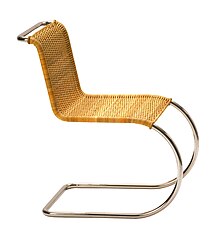Weißenhof chair
The Weißenhof chair (also called MR 10 or MR 20) was designed in 1927 by the architect Ludwig Mies van der Rohe (1886–1969). This first, springy cantilever chair was shown at the Weißenhof exhibition in 1927 . It was made of 25 mm steel tubing and covered with iron thread straps or a braid from Lilly Reich .
history
The first drafts were created under the impression of Mart Stam's tubular gas chair, which, as the first chair without back legs, is the forerunner of all cantilever chairs or cantilever chairs .
Sergius Ruegenberg , then an employee in Mies van der Rohe's office, describes the creation of the Weißenhof chair in 1985 as follows:
“Mies came back from Stuttgart in November 1926 and told us about Mart Stam and his chair idea. We had a drawing board on the wall, on which Mies drew the Stam chair, at right angles, starting from above. He also added the sleeves and said:
'Ugly, something ugly with these sleeves. If it had at least rounded it would be nicer 'and sketched an arch. - Only a bow from his hand on the Stam sketch made the new chair. "
literature
- Chair Museum Burg Beverungen (Ed.): The cantilever chair . König, Cologne 1998, ISBN 3-88375-351-3 .
